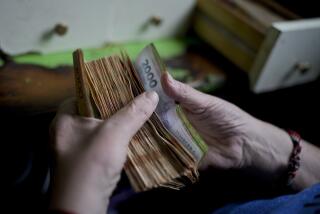Mexico’s Plastic Pesos Fit the Bill
- Share via
TIJUANA — TIJUANA -- Cash has taken on a shiny new face in Mexico, where the government has introduced currency that is supposed to outperform the standard peso -- lasting longer, staying drier and even helping prevent the spread of bacteria.
Mexico recently debuted the plastic 20-peso note, designed to be more durable than paper money. The bills cost more to produce but are expected to last four times longer than ordinary pesos, which often became ragged and ripped after nine months.
The move toward plastic currency began in Australia in 1988 and has spread to more than 20 countries, mostly those -- such as Bangladesh, Thailand and Indonesia -- where high humidity can turn bills into a soggy mess.
Australia prints the currency for several nations and was hired to make Mexico’s first batch of bills. Bruno Garoffolo, marketing manager for Securency, the Australian company that produces the polymer film, said the new bills repel moisture.
“In those countries, paper bank notes will get very smelly and very worn in a short period of time,” he said. “That’s where the polymer note really jumps ahead.”
Mexico is the first country in North America to experiment with the innovative currency, which is slippery to the touch.
The 20-peso notes, worth about $2, look the same as paper bills, with a blue background and a portrait of revered 19th century President Benito Juarez. They are flexible enough to fit into a wallet, but they are hard to crumple and nearly impossible to tear by hand. They also have added protections to discourage counterfeiting, including a transparent window engraved with the number 20 and an image formed with two 20s that can be seen only against a light.
When asked about the new currency, hair salon manager Noel Valdez of Tijuana pulled out an old and a new bill and sprayed both with water to demonstrate his point. The drops soaked the paper peso and rolled off the plastic bill.
“They don’t get wet, they don’t get dirty and they don’t rip,” Valdez said, as a co-worker at Filenes salon teased that he should do a commercial for the bank. “They’re not so fragile.”
Marisela Hernandez said the new security features will come in handy at her bakery along Avenida Revolucion in Tijuana, where she is already seeing more customers pulling out the plastic cash. To check for fake paper money, she has to draw a line on the bill and wait to see what color it turns. But to determine if the polymer money is counterfeit, all she has to do is hold it up, peer through the clear window and look for the engraved 20.
David Mendoza, who sells newspapers and magazines at a stand nearby, predicted that other countries will follow the trend. “It’s more practical,” he said. “If they can do it, why not?”
The United States has studied the currency but doesn’t plan to make the switch, said Claudia Dickens, spokeswoman for the Bureau of Engraving and Printing. Dickens pointed to the increased cost as a deterrent.
“For right now, we are staying with the cotton and linen blend,” she said. “But that’s not to say we won’t consider a polymer material in the future.”
The Bank of Mexico may replace all of its paper currency, depending on how the new bills fare, according to Jaime Pacreu, director of note issue. The old 20-peso bills change hands frequently and deteriorate quickly, causing the bank to be constantly printing new cash.
The bank’s Web site highlights the plastic pesos, showing an enlarged picture, describing the benefits and warning users not to staple or burn them. In addition to durability, bank officials said, the bills are more hygienic because they don’t attract as much bacteria.
Even though the cost of production is 50% higher, Pacreu said he’s sure the bank will get its money’s worth. It has already issued 178 million new notes and is beginning to collect paper bills.
Just steps from the border in Tijuana, Graciela Reyes sells blankets, statuettes and jewelry to visitors. She doesn’t care if the bills are plastic or paper, just as long as they’re in her hands.
“Money is money, it doesn’t matter,” she said. “I just want the tourists to bring more of it.”
More to Read
Sign up for Essential California
The most important California stories and recommendations in your inbox every morning.
You may occasionally receive promotional content from the Los Angeles Times.













